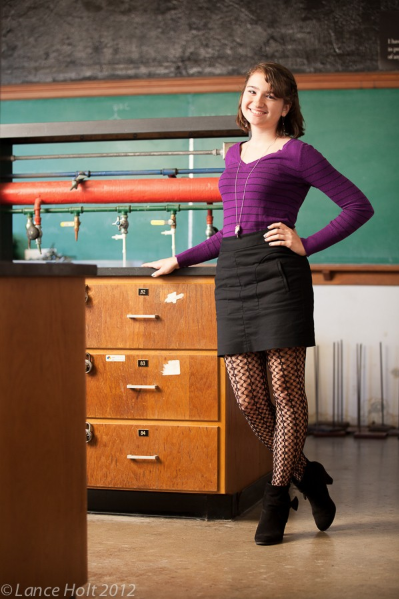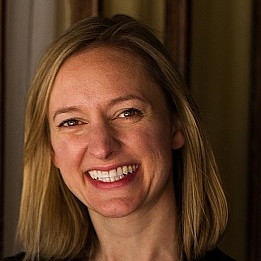News
The Science and Art of Salamanders
Kira McEntire ’13 explores creative expression while teaching and researching wildlife biology.
January 11, 2019
January 11, 2019

“When I started at Southwestern, I really, really wanted to major in herpetology,” says Kira McEntire ’13. From the Greek herpein meaning “to creep,” the word herpetology refers to the branch of zoology concerned with the study of amphibians (think frogs, toads, and newts) and reptiles (including snakes, lizards, turtles, tortoises, and crocodiles). Unfortunately for McEntire, a major in herpetology “is not a thing at any undergrad institution.”
The source of McEntire’s interest in things that creep and crawl was the humble but captivating salamander. “When I was about nine, I found some skinks [lizards of the family Scincidae] under the house,” she recalls. “I thought they were salamanders because they moved like salamanders. I learned the word herpetology, and I just loved the reptiles and amphibians around the house. I thought, ‘Oh my god, this is so cool!’”
She didn’t get to see a salamander in the wild until she studied at Southwestern. McEntire had decided that majoring in environmental studies would be the most effective way to study her beloved salamanders, and Professor of Biology Max Taub encouraged her to add a second major in his home department, which enriched her understanding of biodiversity and evolution more broadly. But McEntire’s passions extended beyond the sciences to creative expression, so she also declared a studio art minor. She sees her interdisciplinary interests as interconnected: “I’d always been an artist, and I always really loved art,” she says, “but I started using art as a means of communication, as a form of scientific outreach. It’s a great way to get people interested in science and get them talking about scientific ideas.” Her pieces appeared in art shows and included vases and mugs, and a King Creativity grant funded a large mosaic mural that she created out of recycled ceramic fragments, broken tiles, and found objects for the Environmental Studies Lounge in Mood–Bridwell Hall. True to her fascination with the amphibians, the young artist–scientist often shaped her ceramics to resemble different types of salamanders.
Savvy salamanders steal sperm for the survival of their species
McEntire dabbled in other fields during her time at Southwestern, including studying animals from an interdisciplinary perspective in a first-year seminar titled Going to the Dogs, led by Professor of Kinesiology Jimmy Smith and Professor of Religion Laura Hobgood. The class—and Hobgood’s penchant for carrying foster puppies around in her shirt—inspired McEntire to begin volunteering at the Georgetown Animal Shelter, which expanded her social network into the dog-rescue community. But salamanders remained at the forefront of her research. Her honors thesis for environmental studies focused on the impact of land use and development on the Georgetown Salamander, which was being considered for listing as an endangered species. She also had the opportunity to engage in marine ecology and conservation when she studied away at the Highlands Biologic Station in North Carolina. During her two-week stay, she encountered 21 different species of salamander, with 13 at her study site alone. “They’re just incredibly fascinating,” McEntire says animatedly. “Salamanders ignore all these ecological rules.”
For example, the unisexual Ambystoma salamander only exists in the female variety, and they reproduce by parthenogenesis, a form of asexual reproduction in which offspring are essentially clones of their parent. Namely, these surprisingly long-lived salamanders reproduce through kleptogenesis, which, if you know your Greek, you might guess results from theft. That’s right: these clever little ladies steal sperm from deposits left on leaves and twigs by other closely related salamander species. This petit larceny stimulates egg production, and the purloined genetic information is sometimes incorporated into the genome of the sperm-filching amphibians. “Researchers are analyzing how they survived so long,” says McEntire, “because sexual species usually survive longer because they have more genetic variability.” Against all expectations, these salamanders live for 20 to 30 years, and although most asexual species tend to die off after 100,000 years, these resourceful survivors have likely existed for approximately 5 million years. “Salamanders are so fascinating and do strange and surprising things,” McEntire comments. “My lifelong obsession has been confirmed by all my experiences with them.”
Wildlife biology: A multidisciplinary field
After graduation, McEntire worked as a research assistant with Southwestern Professor of Biology Ben Pierce, who had encouraged her interest in herpetology throughout her undergraduate career. She then set off for the Warnell School of Forestry and Natural Resources at the University of Georgia (UGA), in Athens. There, she spent the next five years earning her Ph.D. in forest resources, specializing in wildlife biology. Although she would expand her interests, salamanders would remain a key part of her study: Her dissertation would ultimately include examination of the relationship between the amphibian’s climbing behaviors and the management of Rhododendron shrubs and trees in southern Appalachia.
Throughout her doctoral research, McEntire continued to work as a field biologist, with nature as her laboratory. But she eventually added computer simulation and modeling into the mix. It’s an aspect of biology that some young scientists might not expect: the hours of running models and interpreting statistics on a computer screen rather than just observing wildlife at field sites. But McEntire loves that such work enables intriguing discoveries, and seeing patterns of reaction and interaction among organisms and their environments on the computer screen appeals to her aesthetic sensibilities as well. “Simulation modeling has a really great interface with animation. I think the artistic side of me likes it,” she comments. Unsurprisingly, McEntire’s graduate advisor would occasionally side-eye the young biologist’s models because her favorite creeping amphibian would make occasional appearances: “I often made my digital agents look like salamanders,” McEntire laughs.
A scholar, a teacher, a dancer
For McEntire, part of the thrill of biology is that “you can wear so many hats depending on the situation. You can be an organismal ecologist, a behavioral ecologist, and a herpetologist” all at once. But that ability to take on multiple roles extends beyond her role as a researcher of wildlife science.
For example, as a one-time doctoral candidate and now a newly minted professor, one of McEntire’s other hats, of course, is teacher. Throughout college and graduate school, the young herpetologist discovered her love for teaching. At Southwestern, she served as an astronomy teaching assistant, running the telescope and helping fellow students learn about constellations at the Fountainwood Observatory. Like most instructors, she reveled in those a-ha moments: watching students understand a new idea or apply a new concept. At UGA, she took a course on the cognition of learning—or “learning how learning works,” as she describes it. It was a game-changer for McEntire. “I first thought that a teacher is a fountain of knowledge sharing what they know,” she reflects, “but really, it’s about helping students figure it out themselves. Lecturing is not the best way to learn. I love coming up with in-class activities to get students thinking about things a different way and engaging in a different way. It’s a magical moment when you see a student change their perspective. It’s really rewarding.”
Since August 2018, McEntire has been sharing those magical moments with her students at Trinity University, in San Antonio, where she is now a visiting assistant professor of biology. There, she’s enjoying being back on a small liberal-arts campus and working to cultivate the kind of long-lasting mentorships that she benefited from as a student at Southwestern with Hobgood, Pierce, Professor of Biology Romi Burks, and Associate Professor of Environmental Studies Joshua Long.
But, ever the artist, another hat McEntire is donning is that of a social dancer. As a child, McEntire spent nine years dancing competitively, primarily in jazz and contemporary styles. In grad school, she discovered a fierce love of ballet as well as ballroom and swing dancing. “Now I can’t imagine life without it. I love that dancing is social, it’s a physical activity, and it’s a creative outlet.” Just as she sees ceramics as a means of starting a discussion, McEntire connects dance with dialogue: “You’re having a conversation about the music with your body instead of with words. … It’s how we connect with other people and how we can express ourselves.” The intense appeal of dance is both personal and global: “It is such a major part of communities worldwide. … There are different dialects, different sets of moves people know, [and] different types of music, but there’s a shared language that’s international.”
Persistence and getting comfortable with the unknown
Whether it’s dance or science, perseverance and embracing uncertainty remain central to McEntire’s approach to learning. She wants students to practice persistence, even in the face of frustration at the lack of a clear solution to a problem. “One of the things I’ve noticed in students especially is that if you will just keep trying things, you’ll get a little further,” she observes. “Don’t just give up and say, ‘It didn’t work’ after the first try. We all want to be able to do a thing and be done with it, but being able to work through a problem is so much more valuable,” she advises. It’s a lesson Southwestern students have come to learn as “effective failure”: to see any mistakes, as often happen in a lab experiment, or missteps, as frequently occur on the dance floor, as opportunities to reassess, try again, improve, and learn.
Part of that courageous refusal to give up on a difficult problem or challenge relates to being able to cope with ambiguity or uncertainty—a crucial element of scientific study. “When I’m teaching labs in ecology, it’s not ‘is this the right answer?’ It’s ‘form a hypothesis,’” McEntire says. “The right answer is whatever you think as long as you can defend it.” That’s an understanding of science that professors and independent researchers have recognized for centuries but that many people—and not just undergraduates—struggle with. After all, we’re often led to believe that there can only be a right or a wrong, with no other options. It’s a lesson McEntire has certainly had to learn throughout her career, including in her study of salamanders and Rhododenron: “Sometimes there’s a wrong answer, but there’s not a completely right answer, either. Sometimes you come to the answer of ‘we’re not really sure.’ You have to get comfortable with the unknown—with having ‘it depends’ as the answer. … You may not be able to appreciate you’re learning, but you will later. Because you actually are learning something from it. It’s a little intimidating, but it’s worth the effort.”















